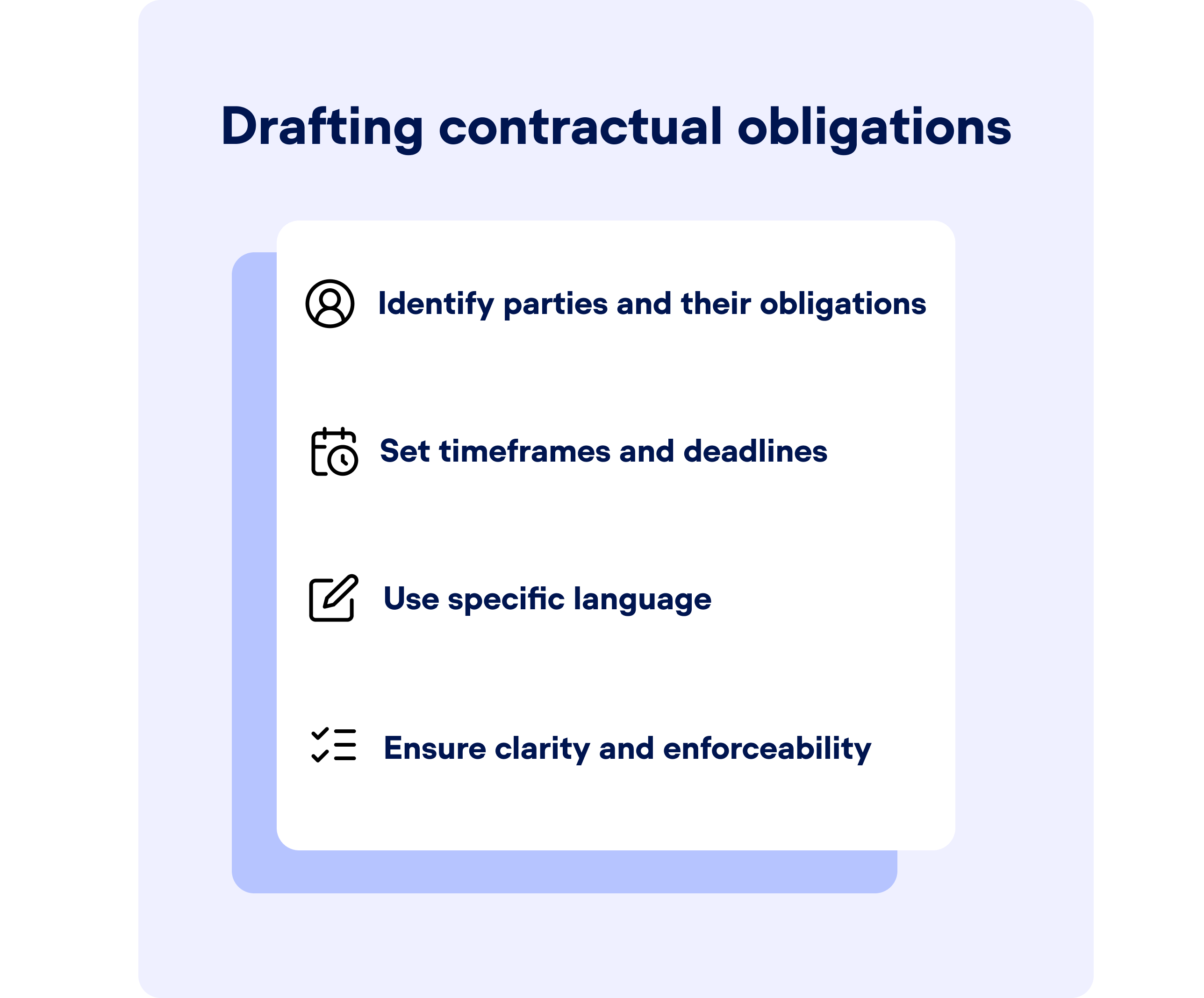Table of contents
- Definition of contractual obligations
- Understanding contractual obligations
- 3 key aspects of contractual obligations
- Drafting contractual obligations
- Examples of contractual obligations
- Enforcing contractual obligations
- Contractual obligations - key takeaways
-
About Concord
Effortless contract management, from drafting to e-signing and beyond. Book a live demo to see Concord in action.
Request demo
Definition of contractual obligations
Contractual obligations are the promises that parties agree to fulfill as part of a legally binding contract. These obligations create a framework for cooperation, setting clear expectations and responsibilities for everyone involved. By setting out clear guidelines for how the parties to a contract interact with each other, contractual obligations establish a solid foundation for ongoing collaboration.
Understanding contractual obligations
Parties involved: obligor and obligee
Contractual obligations involve two main parties: the obligor and the obligee.
- The “obligor” is the person or party who has a responsibility to do something.
- The “obligee,” on the other hand, is the person or party who benefits from that responsibility being carried out.
In a vendor-client relationship, for example, the vendor is the obligor as they are responsible for delivering the goods or services. The client, meanwhile, is the obligee, as they have the right to receive those goods or services and benefit from them.
Mutual rights and responsibilities
Contractual obligations include mutual rights and duties. This means that as the obligor has certain responsibilities, while the obligee gains corresponding rights.
For instance, if a company hires a marketing agency to promote its products, the agency has a responsibility to execute effective marketing strategies. At the same time, the company has the right to expect good results.
Positive and negative obligations
Contractual obligations can be categorized into positive and negative obligations. Positive obligations involve a party having to do certain things or complete specific tasks.
Example: A manufacturer has a positive obligation to deliver a particular amount of goods by a specific date.
On the other hand, negative obligations prohibit parties from engaging in certain activities.
Example: An employee might have a negative obligation not to share confidential company information with competitors.
3 key aspects of contractual obligations
You’ll want to get familiar with three main aspects of contractual obligations:
- Specificity and enforceability
- Reading and understanding obligations before signing
- Consequences of breaching obligations
Let’s take a look at each of these in more detail.
1. Specificity and enforceability
One important aspect of contractual obligations is specificity. Clear and precise language is essential to avoid ambiguity in contracts and ensure that each party understands its duties. Enforceability is also crucial. The obligations outlined in a contract should be legally binding, with remedies available in case of non-compliance.
2. Importance of reading and understanding obligations before signing
Before signing a contract, you’ll want to carefully read and understand the obligations outlined in it. Understanding the scope, timelines, and conditions of the obligations helps prevent misunderstandings and disputes later on. If you’re unsure about anything, ask for more information, and make sure you’re comfortable with the terms before committing.
3. Potential consequences of breaching contractual obligations
Breaching contractual obligations can have serious consequences. It can damage the trust between you and another party — and in some cases it can also lead to financial losses, or even legal action. Clear communication and collaborative problem-solving help keep you and other parties on the same page about your obligations.
Drafting contractual obligations
Here’s a step-by-step guide to drafting clear and enforceable obligations.
- Identify the parties to a contract and clearly explain their obligations.
- Set realistic timeframes and deadlines.
- Use language that’s easy to understand.
- Make sure the contract is clear and enforceable.
Now let’s explore all four of these steps in more detail.
1. Identify parties and their obligations
When drafting contractual obligations, you need to clearly identify the parties involved and their respective obligations. Use simple language, and don’t leave any room for misinterpretation. It’s also important to consider the specific needs and goals of each party, and tailor the obligations accordingly.
2. Set timeframes and deadlines
Specify realistic timeframes and deadlines for fulfilling obligations. Make sure to clearly state the details of each obligation.
3. Use specific language
Use language that’s easy to understand, to avoid any chance of confusion or miscommunication. If possible, provide examples or practical guidelines to illustrate expectations. This will help all parties understand and fulfill their obligations.
4. Make sure your contract is enforceable
It’s often worthwhile to ask a legal professional to review your contract, to make sure its terms are enforceable. A legal expert can check that the language used is legally valid, and that the obligations are enforceable in a court of law. You can also use contract lifecycle management software with features that support enforceability, such as contract templates and clause libraries.

Examples of contractual obligations
Payment terms and delivery obligations
One common example of a contractual obligation is the payment terms agreed upon between parties. These terms specify the amount, method, and schedule of payments. Similarly, delivery obligations outline the timeline, location, and conditions for delivering goods or services.
Performance of services and meeting quality standards
In service-based contracts, obligations often revolve around the performance of specific tasks or the provision of services. You should establish clear expectations regarding the quality, timeline, and scope of the services to make sure both parties are aligned and satisfied with the outcomes.
Non-disclosure and non-compete obligations
Non-disclosure agreements and non-compete obligations are frequently included in contracts to protect sensitive information and maintain a competitive advantage. These obligations prohibit one party from disclosing confidential information or engaging in competing activities during or after the contractual relationship.
Enforcing contractual obligations
Legal options for resolving disputes
In the event of a dispute or breach of contractual obligations, you may need to resort to legal action to resolve the issue. This may involve negotiation, mediation — or, if necessary, pursuing litigation. Make sure you understand your options, and consider consulting with a lawyer before pursuing legal action.
Seeking remedies for breaches of obligation
When one party fails to fulfill their contractual obligations, the non-breaching party can seek remedies to address the harm caused. Remedies can include compensation for financial losses, specific performance to enforce the obligation, or termination of the contract. Again, it’s smart to consult a legal professional for guidance on the available remedies and the best course of action.
Importance of documentation and record-keeping
To enforce contractual obligations successfully, you’ll need to maintaining documentation and records. Keep copies of the contract, communication exchanges, and any evidence of performance or non-performance. These records serve as important evidence in case of disputes and help to resolve them more efficiently. The most secure way to store documentation is a cloud-based contract database, especially one included in a contract management platform.
Contractual obligations – key takeaways
Contractual obligations define the responsibilities and commitments of each party involved, helping both sides to get the most out of the partnership.
By paying attention to your contract’s wording, terms, and enforceability, you’ll be able to define contractual obligations with confidence.
Main points to bear in mind for understanding and fulfilling obligations:
- Clearly define the obligations and roles of the parties involved.
- Read and understand obligations before signing a contract.
- Know the consequences of breaching contractual obligations.
- Seek legal advice to make sure your contract is enforceable.
- Maintain accurate documentation and records throughout the contract.





